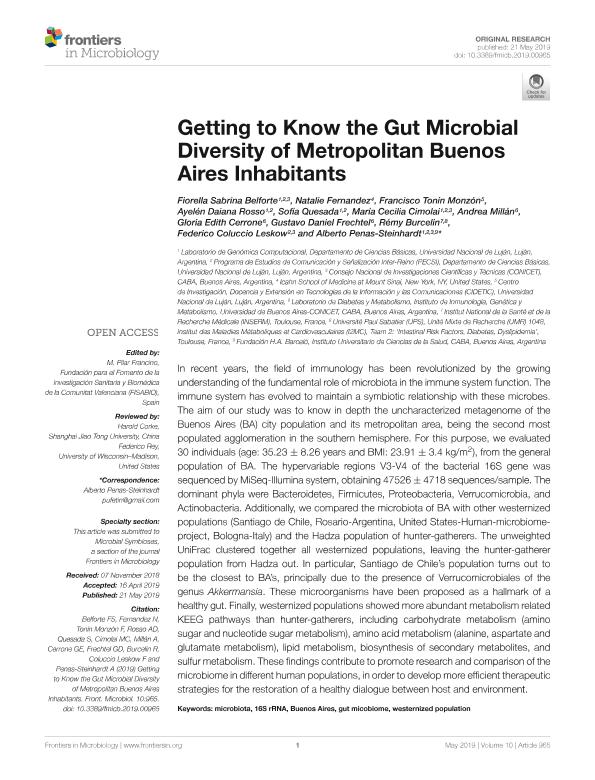Artículo
Getting to Know the Gut Microbial Diversity of Metropolitan Buenos Aires Inhabitants
Belforte, Fiorella Sabrina ; Fernandez, Natalie; Tonin Monzón, Francisco; Rosso, Ayelen Daiana; Quesada, Sofía; Cimolai, María Cecilia
; Fernandez, Natalie; Tonin Monzón, Francisco; Rosso, Ayelen Daiana; Quesada, Sofía; Cimolai, María Cecilia ; Millán, Andrea Liliana
; Millán, Andrea Liliana ; Cerrone, Gloria Edith; Frechtel, Gustavo Daniel
; Cerrone, Gloria Edith; Frechtel, Gustavo Daniel ; Burcelin, Rémy; Coluccio Leskow, Federico
; Burcelin, Rémy; Coluccio Leskow, Federico ; Penas Steinhardt, Alberto
; Penas Steinhardt, Alberto
 ; Fernandez, Natalie; Tonin Monzón, Francisco; Rosso, Ayelen Daiana; Quesada, Sofía; Cimolai, María Cecilia
; Fernandez, Natalie; Tonin Monzón, Francisco; Rosso, Ayelen Daiana; Quesada, Sofía; Cimolai, María Cecilia ; Millán, Andrea Liliana
; Millán, Andrea Liliana ; Cerrone, Gloria Edith; Frechtel, Gustavo Daniel
; Cerrone, Gloria Edith; Frechtel, Gustavo Daniel ; Burcelin, Rémy; Coluccio Leskow, Federico
; Burcelin, Rémy; Coluccio Leskow, Federico ; Penas Steinhardt, Alberto
; Penas Steinhardt, Alberto
Fecha de publicación:
05/2019
Editorial:
Frontiers Media S.A.
Revista:
Frontiers in Microbiology
ISSN:
1664-302X
Idioma:
Inglés
Tipo de recurso:
Artículo publicado
Clasificación temática:
Resumen
In recent years, the field of immunology has been revolutionized by the growing understanding of the fundamental role of microbiota in the immune system function. The immune system has evolved to maintain a symbiotic relationship with these microbes. The aim of our study was to know in depth the uncharacterized metagenome of the Buenos Aires (BA) city population and its metropolitan area, being the second most populated agglomeration in the southern hemisphere. For this purpose, we evaluated 30 individuals (age: 35.23 ± 8.26 years and BMI: 23.91 ± 3.4 kg/m2), from the general population of BA. The hypervariable regions V3-V4 of the bacterial 16S gene was sequenced by MiSeq-Illumina system, obtaining 47526 ± 4718 sequences/sample. The dominant phyla were Bacteroidetes, Firmicutes, Proteobacteria, Verrucomicrobia, and Actinobacteria. Additionally, we compared the microbiota of BA with other westernized populations (Santiago de Chile, Rosario-Argentina, United States-Human-microbiome-project, Bologna-Italy) and the Hadza population of hunter-gatherers. The unweighted UniFrac clustered together all westernized populations, leaving the hunter-gatherer population from Hadza out. In particular, Santiago de Chile?s population turns out to be the closest to BA?s, principally due to the presence of Verrucomicrobiales of the genus Akkermansia. These microorganisms have been proposed as a hallmark of a healthy gut. Finally, westernized populations showed more abundant metabolism related KEEG pathways than hunter-gatherers, including carbohydrate metabolism (amino sugar and nucleotide sugar metabolism), amino acid metabolism (alanine, aspartate and glutamate metabolism), lipid metabolism, biosynthesis of secondary metabolites, and sulfur metabolism. These findings contribute to promote research and comparison of the microbiome in different human populations, in order to develop more efficient therapeutic strategies for the restoration of a healthy dialogue between host and environment.
Palabras clave:
HUMAN MICROBIOME
,
METAGENOME
,
16S SEQUENCING
Archivos asociados
Licencia
Identificadores
Colecciones
Articulos(INEDES)
Articulos de INSTITUTO DE ECOLOGIA Y DESARROLLO SUSTENTABLE
Articulos de INSTITUTO DE ECOLOGIA Y DESARROLLO SUSTENTABLE
Articulos(INIGEM)
Articulos de INSTITUTO DE INMUNOLOGIA, GENETICA Y METABOLISMO
Articulos de INSTITUTO DE INMUNOLOGIA, GENETICA Y METABOLISMO
Articulos(SEDE CENTRAL)
Articulos de SEDE CENTRAL
Articulos de SEDE CENTRAL
Citación
Belforte, Fiorella Sabrina; Fernandez, Natalie; Tonin Monzón, Francisco; Rosso, Ayelen Daiana; Quesada, Sofía; et al.; Getting to Know the Gut Microbial Diversity of Metropolitan Buenos Aires Inhabitants; Frontiers Media S.A.; Frontiers in Microbiology; 10; 5-2019; 965-965
Compartir
Altmétricas



